“Loss of the Colwood open space could also result in a permanent gap in the 40-Mile Loop Bike and Pedestrian Trail.”
— Tony Fuentes, NE Portland resident and member of the Keep Colwood Green! Coalition
Citizen activists and a host of environmental organizations and neighborhood associations are hoping to save 138 acres of open space that straddles the Columbia Slough in Northeast Portland.
If successful, they’ll save not only a potential new regional park, but they’ll keep the door open for a future connection of Portland’s venerable 40-Mile Loop — a trail that was originally conceived over 100 years ago.
The Colwood Open Space (currently home to a golf course just north of Columbia Blvd and West of 82nd Ave.) is being threatened by a rezoning plan that would transform 116 of those acres into industrial space.
Instead of becoming another industrial park, the Keep Colwood Green! Coalition wants to buy the land and turn it into Colwood Regional Park.

According to neighborhood activist (and former contributor to BikePortland.org) Tony Fuentes, the area surrounding Colwood is “extremely park deficient”. He cites a citywide “neighborhood access rate” of 40 people per park acre in Portland — while in the Cully neighborhood, that access rate is 2,780 people per park acre.
Fuentes is leading the charge to create a Colwood Regional Park which he says would, “dramatically enhance the livability of Portland and the region.”
To buy it, the Colwood coalition would go after funds in Metro’s Natural Areas Bond Measure, system development charges (fees assessed to new development to mitigate increases in corresponding infrastructure improvements) and other sources.
The Keep Colwood Green! coalition has already won one major battle — the Bureau of Development Services hearings officer denied the rezoning request back in May citing that the open space is a, “practically irreplaceable asset”.
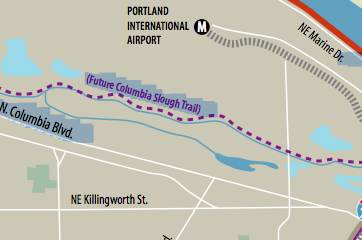
trail is planned through Colwood Open Space.
That decision by BDS will now be sent to City Council for review and a final recommendation on September 17th (next Wednesday). Before Council makes a decision, they’ve scheduled a public hearing that will begin at 6:00pm.
The owners of Colwood Golf Course have hired a consultant to help them push this rezone through.
The Keep Colwood Green! Coaltion is urging Portlanders to submit written testimony and/or show up to City Council and make their voices heard.
City Council Hearing on Colwood Golf Course Rezone
City Council Chambers (1221 SW Fourth Ave.)
6:00pm; September 17, 2008
Read more on this story on the Portland Mercury Blog, in the Portland Sentinel and in the Portland Tribune.
Also visit SaveOurOpenSpace.com for more on the Keep Colwood Green! effort.


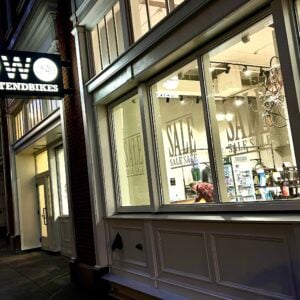
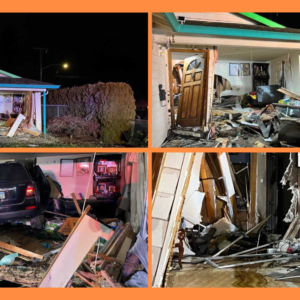
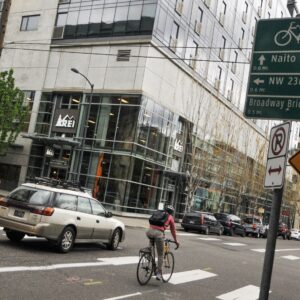
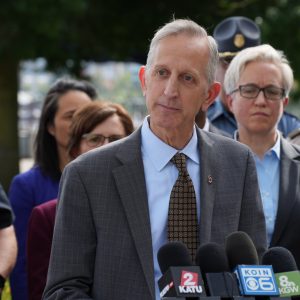
Thanks for reading.
BikePortland has served this community with independent community journalism since 2005. We rely on subscriptions from readers like you to survive. Your financial support is vital in keeping this valuable resource alive and well.
Please subscribe today to strengthen and expand our work.
I don\’t understand why they couldn\’t wind a green space through a light industrial park.
The two uses are not incompatible- it\’s not very green to force people to commute to the edge of town for living wage manufacturing jobs.
Thank you for posting this information Jon. Obviously the impact on future bike trail development is only one of the many critical aspects of this issue.
If you review the facts on this proposal, there is simply no compelling reason to rezone this area. But ultimately, the decision resides with the Council and the proponents to rezone Colwood are pushing hard.
If Council decides to amend the Comprehensive Plan and allow any part of Colwood to be rezoned industrial, the City will lose its primary leverage for shaping how the Port of Portland develops and it will set a dangerous precedent; one that will likely be used by the Port or others to force the rezoning of other significant Open Space such as Broadmoor.
Losing Colwood today, could mean losing a lot more in the future.
Right On Chilly Willy. Jobs and parks both in harmonious coexistence
Chilly,
I hear you if we were talking about a new or existing development in an area already zoned industrial; but we aren\’t.
Since it has been part of the City, Colwood has been zoned Open Space with an environmental conservation overlay. Prior to annexation into the city, Colwood was zoned as an agricultural district (F2-CS) by Multnomah County.
Retaining the Open Space zoning is consistent with what this property has always been. Further, as reflected in the Hearings Officer\’s recommendation, keeping this area Open Space better serves the goals, policies and objectives of the City\’s Comprehensive Plan than industrial zoning will.
At its core, what is being requested is an amendment to the City\’s Comprehensive Plan so the property can be sold to the Port of Portland for $200,000 per acre.
All the best,
Tony
This \”neighborhood\” is an industrial wasteland. If the golf course were turned into a park it would be completly empty except for the homeless that would likely set up camp. I\’ve played golf here a few times, and it\’s proximity between Columbia Blvd and the airport runway makes it a pretty nasty place to be. The parks areas designated on the proposed zoning map are the nicest natural areas of the site. The sites for business blocks are so loud that I wouldn\’t want to be outside.
Do people actually live in this area anyways? I never see anything but industrial trucks and machinery when I am in the area.
Chilly (#2): I wouldn\’t jump to the conclusion that creating this commercial space will create jobs. Just east of this area is a large industrial park with considerable portions currently available for lease. Where I live we have a shortage of light industrial property, but efforts to address that have shown the \”if you build it they will come\” principle false.
I do agree with you that the two uses aren\’t incompatible, though. In fact I\’d consider bike path access quite a valuable feature in allowing safe (and green) alternative transportation to any workplace!
\”He cites a citywide “neighborhood access rate” of 40 people per park acre in Portland — while in the Cully neighborhood, that access rate is 2,780 people per park acre.\”
Wow, that is one skewed fact! I would assume that this includes Forest Park, the biggest park inside city limits in the US. I would be very curious to see what the numbers are without Forest Park which is so large that it isn\’t accessed at all by much of the Portland population.
There is an easy solution to free up a whole lot of land in the area, (both for open space and industrial,) permanently solve airport noise, plan for airport expansion, get more flights out of the airport to more destinations, and get high speed rail to Seattle at the same time:
Merge PDX with SEATAC, close both airports, sell the land they sit on, then build a big airport somewhere near Centralia, and built high speed rail from downtown to Portland to downtown Seattle, with a stop at the airport. Total travel time from downtown Portland to the airport would continue to be about the same as it is right now, and the entire project would actually make a profit.
As a huge fan of mixed use and dense development, I tend to favor multiple use zoning. I do see the importance of green spaces, both for quality of life and for environmental reasons. And there\’s the fact that modern industrial developments are some of the most inefficiently planned spaces, never located near transit hubs, completely dependent upon automobiles for employee access, and road-going trucks for raw material input and final product output.
Some have said that much of this space is not practicable for park use. Why not try to take this less valuable space and use it as a testbed for responsible urban industrial use, which can evaluate transit (people and material), \”green\” energy use, pollution control, and neighborhood context issues.
We\’re always talking about the devastation created by suburban sprawl, but what about the forcing of all manufacturing and industry to leave cities? Are we saying the only people who get to live in Portland are those in the service professions? Or do we replace the rush hour commutes from the suburbs to jobs in the city with equally bad commutes from the cities to distant outlying areas?
I think there\’s room in this space for both a park (with 40-mile loop access) and a responsible new way to incorporate industry near population centers, and make the city even more livable.
Don\’t forget that a golf course is not exactly the model of eco-friendliness, as it is. It\’s usually a huge pesticide dump, together with all the wastefulness that\’s associated with keeping so much grass cut and watered.
there\’s already acres and acres of developable commercial and industrial land to the east of Colwood, north of Columbia Blvd. between NE 82nd and I-205, and more on the east side of I-205.
That would be a GREAT place for a park! I ride my bike (and motorcycle) through that area all the time, already, enjoying all the green space around the slough. Its kinda an industrial area but not bad – not like there are coal burning power plants there or something.
I don\’t think it would be unused (or just by homeless) at all. People already hang out nearby, at the airport, watching the flights coming in and out as well as the incredible sunsets. I would bet they would prefer chilling in a park as opposed to a parking lot!
Not saying my idea has to be there, but it\’s the sort of thing we need to think more about. I know this is a single issue website, but I think bicycling is only part of making a better environment for myself and my community. We need to pack all the activities of a local economy in the bounds of the city, and that means figuring out how we can better integrate industrial areas. I for one hope we don\’t Pearlify the inner Southeast industrial area, but keep industry there while also making it a nice place to spend time in.
I know that many of the people who run these businesses are not to be trusted, but also they have to go up against regulations and zoning that actually encourage destructive behavior. Every minimum parking regulation, every tax break for the trucking industry, all of that makes these places less neighborly, and all this single-use zoning just puts them all together, where they become even more inefficient with our valuable urban space.
You may say \”Keep Colwood green.\” I think, it should be more like: \”Make Colwood better,\” and if that means turning some of it into a park and some of it into responsibly developed industrial area that would otherwise locate outside of Portland, either way, it\’s an improvement on a lousy golf course.
Since this is a \”single issue website,\” let\’s talk about riding the bicycle. This is a tough area to bike into. Gaining access to this proposed park on a bike – unless the 40 mile trail is completed – would be very dangerous. NE Columbia Blvd. does not have bike lanes, and NE Cully Blvd. is a rather narrow, rough road leading in from the South. One could trek up 82nd, which has so-so bike lanes, but one still has to negotiate NE Columbia. From the North, there is Marine Dr. to NE 33rd, jumping on Lombard and heading east, turning north on NE 47th with a less-than-desireable bike lane, onto NE Cornfoot with NO bike lane, and then head east into Colwood.
I work just a few miles to the West, on NE Riverside Way. My commute continues from the South from the Max station at Goose Hollow, through downtown, over the Broadway bridge, up NE 7th Ave, with a brief ride on NE Columbia from NE Lombard PL onto NE 17th Ave. That brief 50 yard shot on Columbia gets pretty hairy some days. 80,000 lb. fully loaded trucks honking loudly when I need to turn onto Columbia and they want me out of their way. I have ridden on NE Columbia for a few miles one time – one time ONLY – and do NOT recommend it, unless one has an organ donor registration and a strong desire to begin donations!
My opinion is mixed. I am one of those people who commute to work into this area. One of a very few who ride in on a bike. It serves the company I work for well – we have quick and economical access to the airport, and both I-5 and I-205 to bring in raw materials, and transport our manufactured product to waiting clients.
I strongly support keeping green spaces green. I do see many other areas that could be developed into industrial use in the area. And, there are quite a few empty buildings and vacant spaces open for lease/purchase. Perhaps those should be filled prior to considering the development of this space. Once this space is covered in hundreds of thousands of square feet of buildings and parking lots, it\’ll cost a whole bunch of money to make it green again!
I thought NE Cully was a city-designated bike route
Thanks for covering this Jonathan. Keeping green space in this part of portland is highly relevant to the issues of environmental justice, equity, sustainability, and livability that we as nonmotorized transportation advocates stumble upon in our work as well. Even if this proposal is not strictly bicycle related, I hope to hear more about it on your website; it\’s time we stopped thinking of home, commercial, transit, and recreation districts as separate unrelated entities but rather interconnected places that exist in relation to one another. Keeping this space green is a movement with roots in the same ideals that are fueling our attempt at transportation overhaul.
Keep up the good work Tony!
I post a comment that didn\’t show up, so if it does later, please excuse any redundancy.
Mike M @ 6 & 7: Cully is home to 14,000 residents, Colwood is part of that neighborhood.
The ride to Colwood from the very farther reach of Cully (about 46th and Fremont) is only about 2 miles. Access would be via Cully Blvd. which is having bike lanes and other safety improvements added.
The 14,000 residents of Cully have a grand total of one park in their neighborhood and that park is 5 acres in size:
http://www.portlandonline.com/parks/finder/index.cfm?action=ViewPark&PropertyID=580&subareas=3
The acre/resident ratio comes from the City\’s Park Bureau Plan as well as the DRAFT Cully-Concordia Schools, Families, Housing Assessment.
The bottom-line is that Cully has less park acres per capita than any other neighborhood in Portland. It\’s neighbor just to the east – Parkrose – is not much better:
http://www.portlandtribune.com/news/story.php?story_id=115465299524057800
Cully is way undereserved in general – parks, sidewalks, bike infrastructure, street and sewer improvements – everything. This would be a boon for that neighborhood. Some areas of the proposed park would have a LOT of airport noise, but planting a large number of trees near the north end would mitigate that somewhat in a couple of decades. (for those of you who think that\’s unimportant, remember that Ladd\’s 70 years ago did not have a SINGLE tree – they completely denuded that area when they originally laid the streets)
BDS is right – a large, open space like this, especially inside 82nd Avenue, is an irreplaceable asset. And above comments are also right – there\’s plenty of developable land in Portland. This is being done solely to make it salable to the Port of Portland, and for the current owner to make a boatload of money. It\’s going to take a lot of public support to keep the zoning change from going through.
Just as with \”dgc\” I work in this same area and commute by bike 95% of the time. Cornfoot is so dangerous for bikes. I talked to Roger Geller a few months back about the proposed trail that runs through colwood. It is not intended to be a bicycle path but instaed a walking path. Unless there is going to be improvements to the roads running through colwood (Cornfoot, alderwood) it doesn\’t seem to help cyclist much. I live only four miles away in NE and If I wanted to take my son to this park I would be driving not riding. Afews years back 47th was closed due to bridge construction over the slough I had to ride killingsworth to cully on to columbia and then down through colwood. I have been commuting for over twenty years and I found that interestion (columbia, alderwood) to be the most dangeous one I have ever experenced.
Matt Picio\’s comment does a good job of summing up what is truly at issue here.
Rezoning one of the last significant pieces of open space on the Columbia Slough to appease the Port and provide a windfall profit to a land owner (basically a ten-fold increase in value) is not worthy of a Comprehensive Plan amendment.
The money is there to acquire this property and I personally don\’t believe we should ever limit our vision for trails and amenities to what we are told will go there – even when the word comes from Roger.
The bottom-line is if Colwood goes industrial, the game is over.
I can see my views are unpopular here, but one thing I would like to say is that the idea that greenspace is always the best use for a parcel of land in terms of environmental issues is just not true. Remember, the suburbs usually contain lots of \”greenspace,\” which is what makes them so bad in terms of transit density. It seems like fairly low value greenspace, when one considers the airport noise, access, and connectedness to neighborhoods. What about consideration of trading this for other higher-value undeveloped lands in the area?
Peejay,
With all due respect, I don\’t think anyone is disagreeing with the core principles you outlined.
Redevelop one of the many empty industrial parcels in the Slough area with mixed-used complementary planning? Dude, I am all ears! But that is not what will be debated and potentially acted upon on 9/17.
What is on the table is a request for a carte blanche rezone that I can guarantee you will be used by the Port to do whatever they damn well please with the area.
Ultimately, the conversion of any part of Colwood to industrial will have an impact on local health and the local environment and will represent a permanent, irreplaceable loss of Open Space. Once it is gone, it is gone – conversion of brownfields is just not the same thing.
Consider the story of Johnson Lake. For decades the lake was a recreational retreat for Portland residents. The lake boasted a beach house to serve the public and a dance hall. People swam, fished, and enjoy the serenity of this special area.
The Owens-Illinois Glass Factory set up shop on the land adjacent to the lake in the 1950’s. They soon began dumping industrial waste into Johnson Lake, much of it containing PCBs. Needless to say, Johnson Lake has not been open to swimming for the past 50 years and fish caught in the lake is unsafe for human consumption.
Access issues? I have ridden there via Killingsworth to Cully Blvd to Colwood. And it is isn\’t a scenic ride but it is no big deal. With some minor improvements, it could be easy and comfortable for just about anyone.
Noise? I have been on the property many times. Once you walk on off the street, it is striking how much noise disappears thanks to the natural buffers of vegetation and the 500 mature trees on site.
If those trees are cut down to allow for industrial growth, it will be a wall of sound rolling right at the Cully neighborhood. Not to mention we will lose a much needed natural filter for the air shed in Northeast Portland.
Undecided on this issue? I am more than happy to talk to you (or anyone) personally about this proposal to provide more details on why I and many, many other people are adamantly opposed to this rezone including:
Urban Greenspaces Institute
Sierra Club
Audubon Society
Oregon Recreation and Park Association
Friends of Smith and Bybee Lakes
Cully Association of Neighbors
Concordia Neighborhood Association
Wilkes Community Group
Parkrose Neighborhood Association
Central Northeast Neighbors
Northeast Coalition of Neighbors
Fox Chase Business Association
North Northeast Business Association
North American Youth and Family Center (NAYA)
And I do respectfully ask that if you already feel the same way about this proposal, by all means send in your testimony and/or show up on 9/17. The folks who want to make this industrial are pushing hard.
They have consultants, they have lobbyists, they have access…we have people like me who are volunteering their time on this issue while still trying to run a business, be a father to two wee ones, and work another job.
You want to talk? Give me a call – 971-570-6930, send me an email: milagros@milagrosboutique.com
Want to let your voice be heard? Here is a link to how to do that:
http://saveouropenspace.com/contact-the-mayor-and-commissioners/
Thank you for listening.
All the best,
Tony
What about consideration of trading this for other higher-value undeveloped lands in the area?
There really are no other higher value undeveloped lands in this area.
The only other park in Cully sits on top of a reclaimed landfill.
Most of the former agricultural land in the area was rezoned commercial / industrial in the mid 80\’s.
In the late 90\’s the city vacated a bunch of undeveloped land along the slough west of I-205, and gave it to the Port for commercial / light industrial use as part of the deal bringing the MAX Red Line to the airport. The Port has been systematically filling in the wetlands on this property and building commercial developments like the Ikea / Cascade Station development. This development will soon spread south to Alderwood, and south of Alderwood the Port has already built the Airport employees parking lot in the E-Zone to the north of the slough.
The Port doesn\’t need new greenspace to develop in this area, they\’ve got a sufficient inventory of developed and developable land already, and they are not particularly good environmental stewards.
#6, I live in this neighborhood and have basically no access to any large park. We have schools where people can access the school grounds and very small parks like wellington but nothing like this.
The park would be easily accessible by bike from the south on cully blvd, as well as from the east on alderwood.
One bike related thing that no one has mentioned is that the park is on a bit of a hill and could easily be developed in part as the much needed and long overdue mountain bike skills park.
I don\’t oppose the Colwood Golf Course continuing to operate as a golf course, or converting the course to another open space business, but I see no reason why we should destroy the only piece of open space left in the cully area so that the owners can make bank selling it people who want to use it in a new and different way. Maintaining a zoning is not some sort of imminent domain nixing of private property owners rights/land grab. Open space was the zoning when they bought it and most local residents want it to stay that way.
Bjorn
I\’d be curious to know the source on the per-capita park acres for Cully and the City. However, the Coalition for a Livable Future\’s Regional Equity Atlas used a different (and I think better measure) and found a similar disparity in neighborhood park access in Cully. The Atlas measured access in terms of proximity, the percent of the population living within a walkable distance (1/4 mile) to parks or nature.
Percent of Population with 1/4 mile walking distance (along walkable streets and trails) to a public greenspace (not counting schools):
CULLY NEIGHBORHOOD: 24%
CITY OF PORTLAND: 51%
PORTLAND METRO REGION: 52%
Percent of population living within 1/4 mile distance (as-the-crow-flys) of a natural area (public or private):
CULLY NEIGHBORHOOD: 5%
CITY OF PORTLAND: 65%
PORTLAND METRO REGION: 64%
In 2000, Cully had roughly 20% child poverty compared to the 12.2% child poverty in the Portland-Metro region.
Cully had 27% people of color in 2000 while the region had roughly 20%.
Jim
Hey any updates on this story? It has been a year since the appeals process ended and these days when I drive by people seem to be playing golf there. Did they decide to keep it a golf course since they couldn’t go industrial with it?
Bjorn